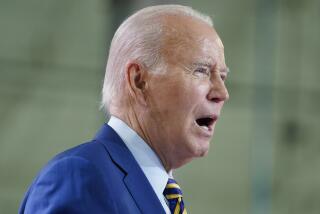Medicare unveils timetable for changing how it pays doctors, hospitals
- Share via
Reporting from Washington — The Obama administration outlined ambitious new goals Monday to transform the way the gargantuan Medicare program pays doctors and hospitals in the next four years, rewarding providers that achieve better outcomes for patients rather than just do more.
The move away from so-called fee-for-service medicine is a central, if little recognized, goal of the Affordable Care Act, which the president signed five years ago.
That shift is seen as critical by most experts to improving the quality of care that patients receive while also restraining costs at a time when millions of baby boomers will be entering the nation’s primary insurance program for the elderly.
Under the goals announced Monday, Medicare will make 30% of its direct payments to doctors, hospitals and other providers through alternative payment models by next year.
These include programs that set a budget for a patient’s care and reward physician practices, hospitals and others who can deliver the care under-budget while achieving good outcomes for patients.
By 2018, half of Medicare’s direct payments to providers should be through such alternative models, according to the federal Department of Health and Human Services.
Now, about 20% of direct payments in the fee-for-service Medicare system are made through alternative models, the agency reported.
“Today’s announcement is about improving the quality of care we receive when we are sick, while at the same time spending our healthcare dollars more wisely,” said Health and Human Services Secretary Sylvia M. Burwell.
“We believe these goals can drive transformative change, help us manage and track progress, and create accountability for measurable improvement,” she said.
The Obama administration did not provide a detailed plan for how this rapid transition would be accomplished.
Burwell told reporters Monday that the health agency is developing regulations and other tools to move doctors, hospitals and other medical providers to alternative payment models.
Despite the lack of specifics, the new goals were broadly hailed by consumer advocates, leading medical providers and insurance industry officials.
“Today’s announcement will be remembered as a pivotal and transformative moment in making our healthcare system more patient- and family-centered,” said Debra L. Ness, president of the National Partnership for Women & Families, a leading consumer advocacy group.
Dr. Douglas E. Henley, chief executive of the American Academy of Family Physicians, also applauded the goals, hailing Monday as a “bless your heart day.”
Medicare will spend more than $600 billion this year to provide medical insurance to some 50 million elderly and disabled Americans.
About a quarter of the program’s beneficiaries receive insurance through a private Medicare Advantage plan; some of these plans already use alternative payment methods designed to reward better-performing doctors and hospitals.
Leading commercial health insurers and employers have also been investing in these kinds of new models in recent years.
But the majority of Medicare beneficiaries are still in what is called the fee-for-service system, a model that reimburses doctors and hospitals based on the number of patient visits or tests of procedures they bill for.
This system has long been criticized for encouraging doctors and others to simply do more, rather than rewarding medical providers who prevent complications and help their patients recover quickly so they do not need further care.
More to Read
Sign up for Essential California
The most important California stories and recommendations in your inbox every morning.
You may occasionally receive promotional content from the Los Angeles Times.














